Twenty-one years ago results were first presented indicating that most of the energy in our universe is not in stars or galaxies but is tied to space itself. In the language of cosmologists, a large cosmological constant -- dark energy -- was directly implied by new distant supernova observations. Suggestions of a cosmological constant were not new -- they have existed since the advent of modern relativistic cosmology. Such claims were not usually popular with astronomers, though, because dark energy was so unlike known universe components, because dark energy's abundance appeared limited by other observations, and because less-strange cosmologies without a significant amount of dark energy had previously done well in explaining the data. What was exceptional here was the seemingly direct and reliable method of the observations and the good reputations of the scientists conducting the investigations. Over the two decades, independent teams of astronomers have continued to accumulate data that appears to confirm the existence of dark energy and the unsettling result of a presently accelerating universe. In 2011, the team leaders were awarded the Nobel Prize in Physics for their work. The featured picture of a supernova that occurred in 1994 on the outskirts of a spiral galaxy was taken by one of these collaborations. News: APOD is now available via Facebook in Hindi.
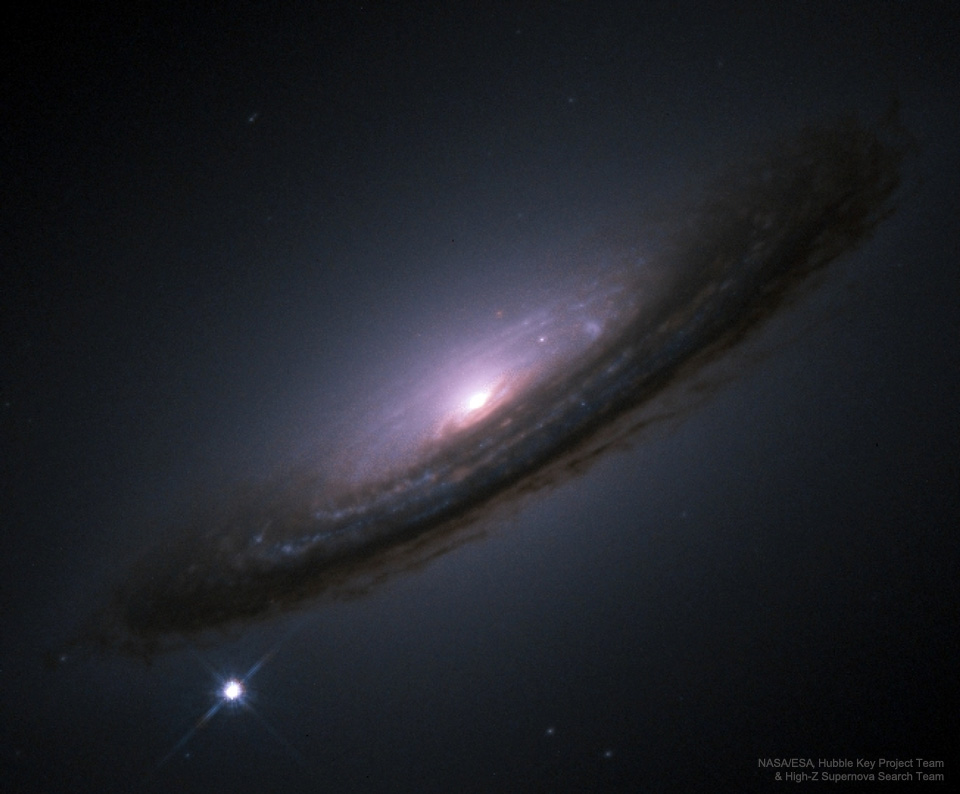
The North Pole of Mars is ringed by a "sea of sand dunes". For Mars' Northern Hemisphere, Spring began in mid July and increased sunlight is now shrinking the polar cap revealing the wind-swept dunes to the cameras onboard the Mars Global Surveyor spacecraft. North is up in this recently released close-up which covers a region about 1.2 miles across at 77 degrees Northern Martian Latitude. These dunes have been formed by winds generally blowing from the Southwest and are still covered with scattered white patches of carbon dioxide frost. Near the end of January 1999 Summer will begin and offer even clearer views of Northern dunes of Mars.

What's in a name? Since 1919, the International Astronomical Union has been charged with the task of establishing "conventional" nomenclature for planets, satellites, and surface features. For the remote Uranian system of moons, namesakes from Shakespearean works have been chosen. Thus Oberon, king of the mid-summer night fairies, is also Uranus' most distant and second largest moon and Hamlet is a tragically large and princely crater on its surface. The above image represents known surface features of Oberon and was constructed by the U.S. Geological Survey (USGS) based on data from NASA's robot explorer Voyager 2. Hamlet is the large dark crater to the right of center. In 1986, Voyager 2 flew through the Uranian system - so far it has been the only spacecraft to do so.
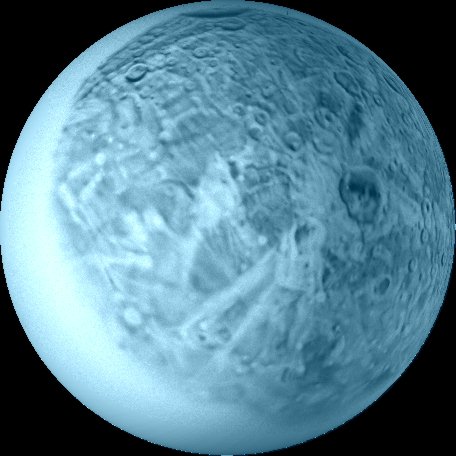
Why is this cluster of galaxies so jumbled? Far from a smooth distribution, Abell 2744 not only has knots of galaxies, but the X-ray emitting hot gas (colored red) in the cluster appears distributed differently than the dark matter. The dark matter, taking up over 75 percent of the cluster mass and colored blue in the above image, was inferred by that needed to create the distortion of background galaxies by gravitational lensing. The jumble appears to result from the slow motion collision of at least four smaller galaxy clusters over the past few billion years. The above picture combines optical images from the Hubble Space Telescope and the Very Large Telescope with X-ray images from the Chandra X-Ray Observatory. Abell 2744, dubbed Pandora's cluster, spans over two million light years and can best be seen with a really large telescope toward the constellation of the Sculptor.
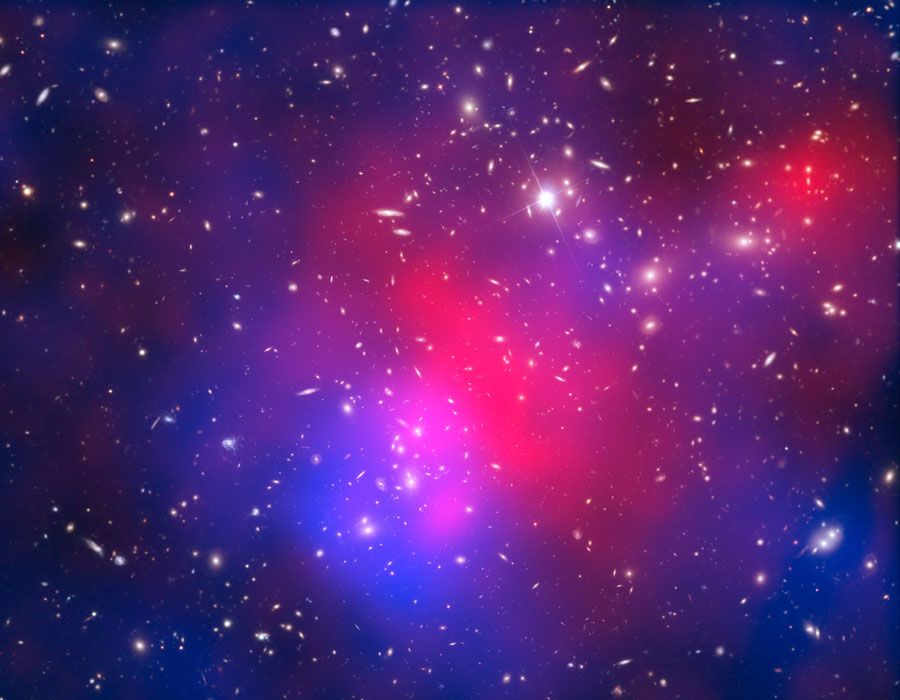
If you could see gamma rays - photons with a million or more times the energy of visible light - the Moon would appear brighter than the Sun! The startling notion is demonstrated by this image of the Moon from the Energetic Gamma Ray Experiment Telescope (EGRET) in orbit on NASA's Compton Gamma Ray Observatory from April 1991 to June 2000. Then, the most sensitive instrument of its kind, even EGRET could not see the quiet Sun which is extremely faint at gamma-ray energies. So why is the Moon bright? High energy charged particles, known as cosmic rays, constantly bombard the unprotected lunar surface generating gamma-ray photons. EGRET's gamma-ray vision was not sharp enough to resolve a lunar disk or any surface features, but its sensitivity reveals the induced gamma-ray moonglow. So far unique, the image was generated from eight exposures made during 1991-1994 and covers a roughly 40 degree wide field of view with gamma-ray intensity represented in false color.
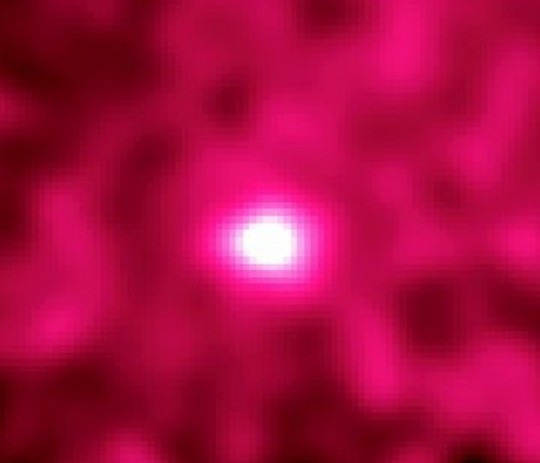
Since Saturn's axis is tilted as it orbits the Sun, Saturn has seasons, like those of planet Earth ... but Saturn's seasons last for over seven years. So what season is it on Saturn now? Orbiting the equator, the tilt of the rings of Saturn provides quite a graphic seasonal display. Each year until 2016, Saturn's rings will be increasingly apparent after appearing nearly edge-on in 2009. The ringed planet is also well placed in evening skies providing a grand view as summer comes to Saturn's northern hemisphere and winter to the south. The Hubble Space Telescope took the above sequence of images about a year apart, starting on the left in 1996 and ending on the right in 2000. Although they look solid, Saturn's Rings are likely less than 50 meters thick and consist of individually orbiting bits of ice and rock ranging in size from grains of sand to barn-sized boulders. Follow APOD on: Facebook (Daily) (Sky) (Spanish) or Google Plus (Daily) (River)
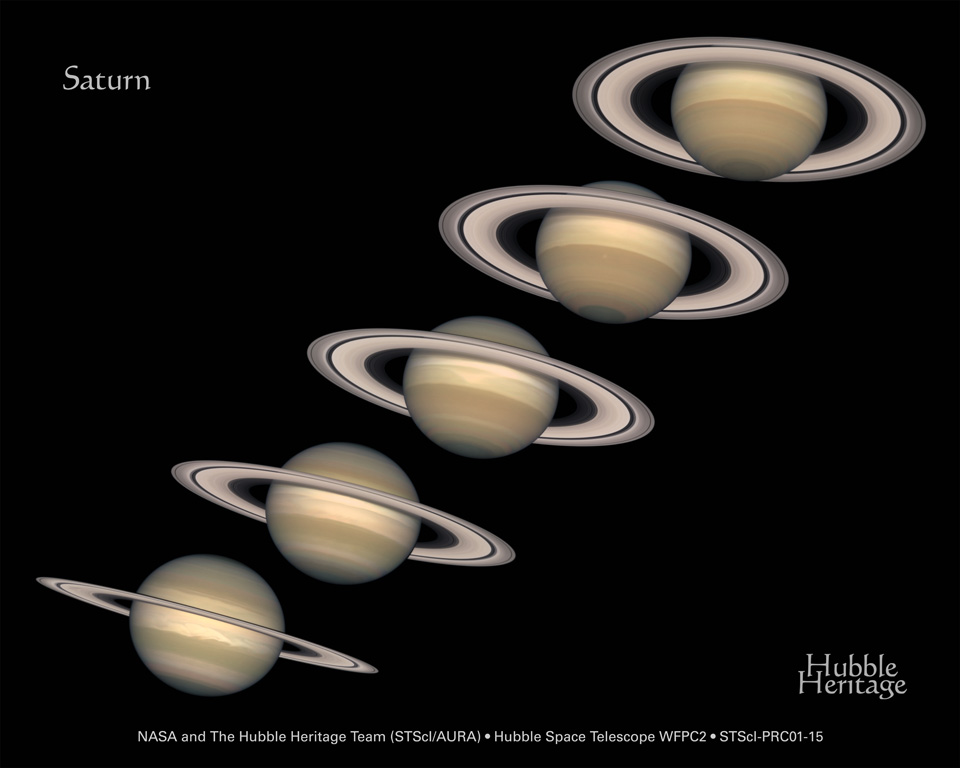
Scroll right and you can cruise along the icy rings of Saturn. This high resolution scan is a mosaic of images presented in natural color. The images were recorded in May 2007 over about 2.5 hours as the Cassini spacecraft passed above the unlit side of the rings. To help track your progress, major rings and gaps are labeled along with the distance from the center of the gas giant in kilometers. The alphabetical designation of Saturn's rings is historically based on their order of discovery; rings A and B are the bright rings separated by the Cassini division. In order of increasing distance from Saturn, the seven main rings run D,C,B,A,F,G,E. (Faint, outer rings G and E are not imaged here.) Four days from now, on November 29, Cassini will make a close flyby of Saturn's moon Titan and use the large moon's gravity to nudge the spacecraft into a series of 20 daring, elliptical, ring-grazing orbits. Diving through the ring plane just 11,000 kilometers outside the F ring (far right) Cassini's first ring-graze will be on December 4.

Tomorrow's picture: Ice Cusps on Europa < Archive | Index | Search | Calendar | Glossary | Education | About APOD > Authors & editors: Robert Nemiroff (MTU) & Jerry Bonnell (USRA) NASA Technical Rep.: Jay Norris. Specific rights apply. A service of: LHEA at NASA/ GSFC &: Michigan Tech. U.

French astronomer Charles Messier was born on June 26, 1730. Inspired by childhood sightings of comets and a solar eclipse visible from his home town of Badonvillier, he became an astronomer and comet hunter who kept careful records of his observations. While hunting for comets in the skies above France he made a now famous list of the positions of about 100 fuzzy, diffuse looking objects which appeared at fixed positions in the sky. Although these objects looked like comets, Messier knew that since they did not move with respect to the background stars they could not be the comets he was searching for. These objects are now well known to modern astronomers to be among the brightest and most striking nebulae, star clusters, and galaxies. Objects on Messier's list are still referred to by their "Messier number". The first object in his catalog, M1 pictured above - also known as the Crab Nebula, was recorded during his search for the return of comet Halley in 1758. Messier died in his home in Paris in 1817.

This luminous night view of the space shuttle orbiter Endeavour, docked with the International Space Station for a final time, was captured on May 28. Orbiting 350 kilometers above planet Earth, Endeavour's payload bay is lit up as it hurtles through Earth's shadow at 17,000 miles per hour. At the top of the frame, the jointed appendages of the station's robotic manipulator arm Dextre appear in silhouette. Motion during the long exposure produced streaks in the starry background and the city lights on the darkened planet below. Completing a 16 day mission, Endeavour made a final landing at Kennedy Space Center in the dark, early morning hours of June 1.
